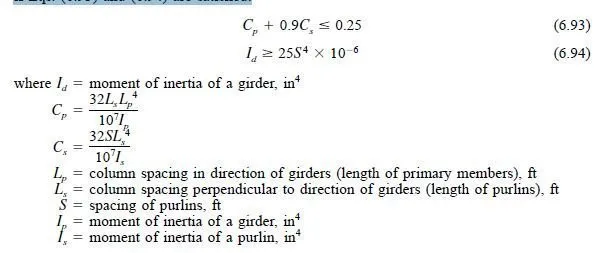This is a state in which the function, appearance, maintainability, and durability of a building and comfort and safety of its occupants are preserved under normal usage. Generally, serviceability limits are based on engineering judgment, taking into account the purpose to be served by the structure, provisions for occupant safety and comfort, and characteristics of collateral building materials. Serviceability checks should be conducted for service loads, not factored loads.
Vertical Deflections. Limits on vertical deflections of a flexural member are not prescribed by the AISC LRFD specification for structural steel buildings. However, the ASD specification limits deflection to 1â„360 of the span L for beams supporting plastered ceilings. Because the deflection limits are application-dependent, the specifications do not give comprehensive criteria. (See J. M. Fisher and M. A. West, Serviceability Design Considerations for Low- Rise Buildings, American Institute of Steel Construction.) The Commentary on the ASD specification suggests that the depth of fully stressed flexural members be at least FyL/800 for floors and FyL/1000 for roof purlins, except for flat roofs.
Ponding. Special consideration should be given to the vertical deflection of roof beams due to ponding, the retention of water caused solely by the deflections of flat-roof framing.
The amount of retained water depends on the flexibility of the framing; as the beams deflect, the depth of ponding increases and increases the deflections even more. Failure of the beams is a possibility. Therefore, according to both the AISC LRFD and ASD specifications, roof systems should be investigated to ensure stability under ponding. Preferably, roofs should be provided with sufficient slope for drainage of rainwater. A flat roof with a steel deck supported on steel purlins may be considered stable, and no further investigation is required if Eqs. (6.93) and (6.94) are satisfied:

For trusses and steel joists, the moment of inertia Is should be reduced by 15% when used in the above relationships.
For ponding analysis, the ASD specification requires, in addition, that the total bending stress due to dead loads, gravity loads, and ponding should not exceed 0.80Fy for primary and secondary members. Stresses resulting from wind or seismic forces need not be included in a ponding analysis.
Drift. Lateral deflections (sidesway or drift) under service loads of a steel frame should be limited so as not to injure building occupants or damage walls, partitions, or attached cladding.
In computation of drift, a 10-year recurrence-interval wind is generally used. The 10- year wind pressure can be estimated at 75% of the 50-year wind pressure. (For design guidance on wind-drift limits, see J. M. Fisher and M. A. West, Serviceability Design Considerations for Low-Rise Buildings, American Institute of Steel Construction.)
Vibrations. In design of beams and girders that will support large areas free of partitions or other sources of damping, the members should be proportioned to limit vibrations to levels below those perceptible to humans. The Commentary to the AISC ASD specification suggests that the depth of steel beams for such areas be at least L/ 20. (See also T. M. Murray, et al, Floor Vibrations Due to Human Activity, Steel Design Guide Series, No. 11, 1997, American Institute of Steel Construction.)
Camber. Camber is a curvature of a flexural member to offset some or all deflections due to service loads. The objective generally is to eliminate the appearance of sagging or to match the elevation of the member to adjacent building components when the member is loaded. Camber requirements should be specified in the design documents.
The ASD specification requires that trusses spanning 80 ft or more be cambered for about the dead-load deflection. Crane girders spanning 75 ft or more should be cambered for about the dead-load deflection plus one-half the live-load deflection.


